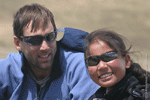
“He who cherishes a beautiful vision, a lofty ideal in his heart, will one day realize it.” As A Man Thinketh
There was an incredible story in the June 18, 2001 issue of Time magazine about Erik Weihenmayer who had recently climbed Mt. Everest.
Now there are quite a few people that have climbed the world’s highest summit since Sir Edmund Hillary first did it in 1953. But no one had ever climbed Mt. Everest that was blind, until Erik Weihenmayer did.
What’s even more amazing is that in 2002 he reached the top of Mt. Kosciusko, the highest peak in Australia. That made Erik the first blind climber to reach the top of the traditional Seven Summits, the most challenging peaks in the world.
Erik can’t see like most of us can, but he knows, like James Allen knew, that if we settle for what we can see today, we’ll never live the life of our dreams. We have to have a vision for our life, for what we want to become. Most importantly, we have to cherish it and hold on tightly to it when circumstances are telling us that we’ll never see our vision.
If you read Erik’s story you’ll discover that Erik stumbled into the Camp on the first floor of Mt. Everest bloodied, sick and dehydrated. And he was still 9,000 feet (almost two miles) from the summit. But Erik had cherished and lived with his vision for years and would not be denied. Like the title of the story says, Erik was “blind to failure.”
The ancient writer tells us in Proverbs that “Without a vision, the people perish.” So we must take the time to determine the vision for our life. But once we’ve settled on our vision, then it’s important that we take James Allen’s advice to cherish it in our heart.
And, as Erik says, “Success is not just the crowning moment, the spiking of the ball in the end zone or the raising of the flag on the summit. It is the whole process of reaching for a goal and, sometimes, it begins with failure.”
And that’s worth thinking about.
